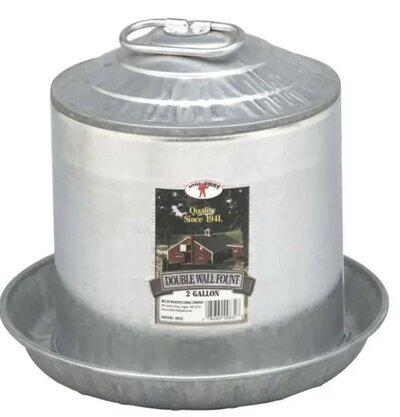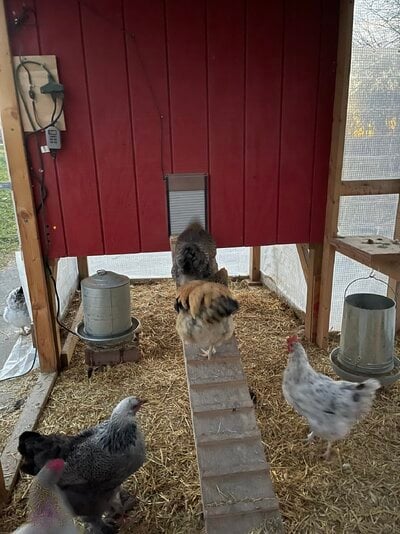Navigation
Install the app
How to install the app on iOS
Follow along with the video below to see how to install our site as a web app on your home screen.
Note: This feature may not be available in some browsers.
More options
You are using an out of date browser. It may not display this or other websites correctly.
You should upgrade or use an alternative browser.
You should upgrade or use an alternative browser.
Feeding and Watering Struggles
- Thread starter cmdeyoung
- Start date
Obsessed With Silkies
Free Ranging
- Jan 15, 2022
- 2,559
- 10,654
- 666
Can you elaborate a bit more on what you need help with? Are you needing recommendations for feed and waterers?
- Thread starter
- #3
I am open to recommendations, but really just want to understand what struggles others have had and how you have overcome them?
For us, its hard to know when out birds are out of water. Often they will tip over their water without us knowing and go a day without water. That's an example of one issue we are having.
For us, its hard to know when out birds are out of water. Often they will tip over their water without us knowing and go a day without water. That's an example of one issue we are having.
Hi, welcome to BYC!
Can you post pictures of what kind of waterers you are using? Are your chickens chicks or adult? That will help us to help you. And if chicks, are they in the house or outside?
Can you post pictures of what kind of waterers you are using? Are your chickens chicks or adult? That will help us to help you. And if chicks, are they in the house or outside?
We have a waterer that holds 3 gallons of water. It is galvanized and sits on bricks in the summer and a heater in the winter. Works well for our 12 ladies. The feeder hangs and holds many pounds of feed. You can see both in this picture. Hope this helps!
Attachments
To keep the waterer from tipping over, attach a hook to the underside of the coop and than run some rope (or a chain) from the handle of the waterer to the hook. There can be a little slack, but you don't want the waterer swinging on the rope. You want enough tension so that when the chickens jostle it, it won't tip over.
You can also put a heavy rubber or metal pan of water on the ground to use as a waterer. You will mostly likely have to clean and refill daily, because they will kick things into it, but it's hard to tip over and easier to scrub out when it needs a deeper cleaning than the gravity waterers. .
You can also put a heavy rubber or metal pan of water on the ground to use as a waterer. You will mostly likely have to clean and refill daily, because they will kick things into it, but it's hard to tip over and easier to scrub out when it needs a deeper cleaning than the gravity waterers. .
Providing clean water to a multi-species flock during the winter. Ducks like bathing and splashing and pooping in the water. Chickens and guinea fowl don't. I ended up using a rubber bowl half covered with a board to prevent swimming in their non-designated swimming area. They still managed to make a mess, so I gave the chickens an alternative of a regular water bowl up on a box where the ducks couldn't reach.I am open to recommendations, but really just want to understand what struggles others have had and how you have overcome them?
For us, its hard to know when out birds are out of water. Often they will tip over their water without us knowing and go a day without water. That's an example of one issue we are having.
For our adult chickens, we water them in buckets. The chicks, in a separate coop (brooder), get theirs in a gallon-size waterer set up on bricks to keep them from kicking bedding into it. So far they've not managed to knock it over, though there's plenty of evidence they park on top of it (King of the Mountain, anyone?).
This is what works for me and the chickens, w/o any issues:
During the non-winter (ie freeze potential months), I have two waterers. One in the main run and one in the secondary run. I use these:

During the winter (freezing months), I remove the waterer from the secondary run and put it into storage. Only the main run has a waterer at this point. I use this type heater base. We have to run an extension cord to the coop for power, so only one waterer.

Each evening around dark, I go to the coop and make sure everyone was inside prior to the pop door shutting. I also check the waterer(s) and fill when needed. During winter, the one waterer tends to need to be filled every other night. During non-winter, I fill a waterer each night, rotating between the two. I have no issues with the chickens knocking over the waterers. The main run waterer does sit on the heated base year round (although it's unplugged in non-winter months). The secondary run waterer sits on an old brake rotor.
For food, during the evening coop check, I remove the feeders (one hanging feeder and one Ratproof Feeder) and put them into the garage/shop. While they are in the shop, I top off/fill them as needed. Each morning, I take the feeders to the coop (usually by 7 am), so they will be there when the pop door opens.
During the non-winter (ie freeze potential months), I have two waterers. One in the main run and one in the secondary run. I use these:

During the winter (freezing months), I remove the waterer from the secondary run and put it into storage. Only the main run has a waterer at this point. I use this type heater base. We have to run an extension cord to the coop for power, so only one waterer.
Each evening around dark, I go to the coop and make sure everyone was inside prior to the pop door shutting. I also check the waterer(s) and fill when needed. During winter, the one waterer tends to need to be filled every other night. During non-winter, I fill a waterer each night, rotating between the two. I have no issues with the chickens knocking over the waterers. The main run waterer does sit on the heated base year round (although it's unplugged in non-winter months). The secondary run waterer sits on an old brake rotor.
For food, during the evening coop check, I remove the feeders (one hanging feeder and one Ratproof Feeder) and put them into the garage/shop. While they are in the shop, I top off/fill them as needed. Each morning, I take the feeders to the coop (usually by 7 am), so they will be there when the pop door opens.
Obsessed With Silkies
Free Ranging
- Jan 15, 2022
- 2,559
- 10,654
- 666
Where did you get the heater base? That looks very useful.This is what works for me and the chickens, w/o any issues:
During the non-winter (ie freeze potential months), I have two waterers. One in the main run and one in the secondary run. I use these:
View attachment 3732933
During the winter (freezing months), I remove the waterer from the secondary run and put it into storage. Only the main run has a waterer at this point. I use this type heater base. We have to run an extension cord to the coop for power, so only one waterer.
View attachment 3732934
Each evening around dark, I go to the coop and make sure everyone was inside prior to the pop door shutting. I also check the waterer(s) and fill when needed. During winter, the one waterer tends to need to be filled every other night. During non-winter, I fill a waterer each night, rotating between the two. I have no issues with the chickens knocking over the waterers. The main run waterer does sit on the heated base year round (although it's unplugged in non-winter months). The secondary run waterer sits on an old brake rotor.
For food, during the evening coop check, I remove the feeders (one hanging feeder and one Ratproof Feeder) and put them into the garage/shop. While they are in the shop, I top off/fill them as needed. Each morning, I take the feeders to the coop (usually by 7 am), so they will be there when the pop door opens.
New posts New threads Active threads
-
Latest posts
-
-
-
-
Open Contest Non-APA/ABA Bantam Rooster Show—2025 BYC Summer Fair
- Latest: Somewhere_In_The_Clouds
-
-
-
Latest threads
-
-
-
1st time chicken owner- little silkie nuggets 😊
- Started by zeroacrehomestead
- Replies: 6
-
-
-
-
Threads with more replies in the last 15 days
-
Open Contest Outdoor Garden Show—2025 BYC Summer Fair
- Started by Debbie292d
- Replies: 120
-
Racoon attack; wing torn and toes gone.
- Started by NewBeeChickGurl
- Replies: 96
-
-
-
Help vets offices closed
- Started by SouthDakotaLiving
- Replies: 71
-
×



